Catalog

SIMEKS
27 products
View:
Telephone number:
E-mail:
simex@simex-ftir.ru
Website: http://www.simex-ftir.ru
Address:
Russia, Novosibirsk, 3/1, 709-717
Website: http://www.simex-ftir.ru
Address:
Russia, Novosibirsk, 3/1, 709-717
- Selected: 0Areas of use
- Selected: 0Item names
- Selected: 0Manufacturer
- Selected: 0Made in
- Selected: 0Additional
View:
26 products
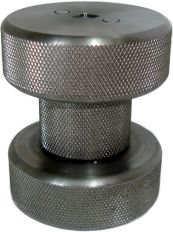
Mini press for producing thin layers of substance on steel mirror plates
It is intended for sample preparation when examining samples using an IR microscope and mirror reflection prefixes.
Allows you to shape a thin layer (up to several microns) to various objects: polymer fragments, microparticles of LCP, powdery substances, fibers, etc.
The resulting thin layers on mirror plates made of alloy steel are investigated by the double transmission method – when the radiation that has passed through the layer of matter is reflected from the surface of the plate and passes through the substance again.
The spectra recorded by this method are completely identical to the transmission spectra obtained, for example, after pressing substances with KBr.
The advantages in this case are:
- speed of sample preparation
- there is no need to use hydraulic and manual presses and molds, grinding mortars, etc.
- no need to use high-purity KBr or petroleum jelly oil
- the sample is not lost and, if necessary, can be examined by other methods
- when using an IR microscope, it is possible to “scan” the resulting thin layer to select the most informative area, and also, if the layer is heterogeneous in composition, to obtain the spectral characteristics of its components.
SIMEKS
Novosibirsk
Produced in: Novosibirsk
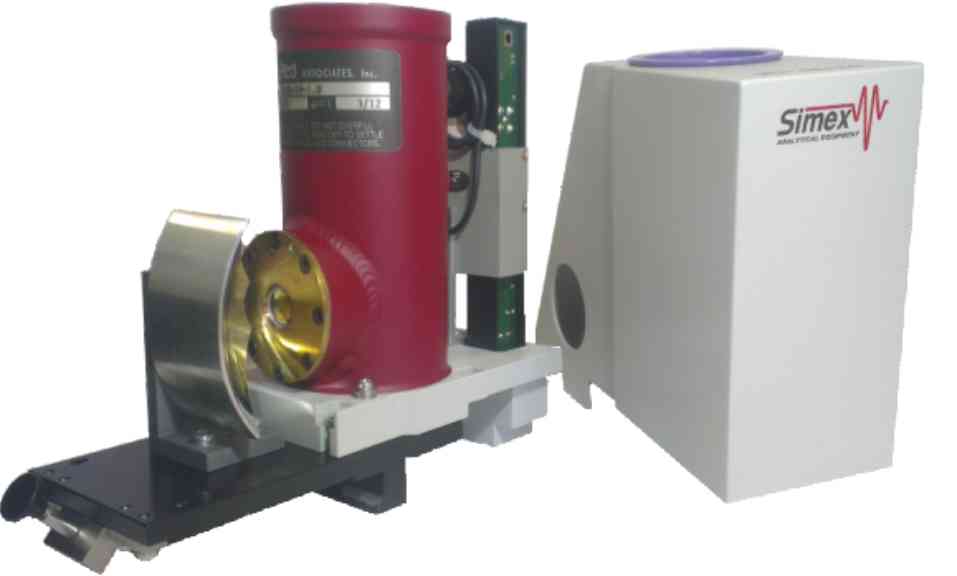
A set-top box with a cooled MST detector
To achieve the maximum sensitivity during measurements, a special prefix is used to the FT-801 Fourier spectrometer, which is an optical unit with a built-in highly sensitive MST detector cooled with liquid nitrogen. The set-top box is installed in the cuvette compartment of the spectrometer and connected to the corresponding external electrical port, the detector is turned on programmatically. In this case, the sensitivity of the method increases many times (up to 20) – depending on the type of standard uncooled detector in the spectrometer). The speed of recording spectra is also increasing. The operating time after filling the cryostat (200 ml capacity) with liquid nitrogen is at least 6 hours.
Increasing the sensitivity of the spectrometer using a prefix with an MST detector may be required for many applications: in fiber spectroscopy, when recording emission spectra of low-power emitters, in trace gas analysis with high spectral resolution, when determining the presence of impurities in samples in ultra-low concentrations, when using multi-pass gas cuvettes, etc.
In the picture: on the left in the cuvette compartment there is a capler with fiber from Art photonics GmbH, Berlin, Germany, on the right there is a prefix with an MST detector.
Technical specifications
The recommended number of scans when registering spectra is 16
Spectrum registration time at 50 scans (resolution 4 cm-1), sec 20
Cryostat capacity, 200 ml
Working time after filling the cryostat, 6 hours
Overall dimensions, mm 225×175×75
Weight, kg 1.45
SIMEKS
Novosibirsk
Produced in: Novosibirsk
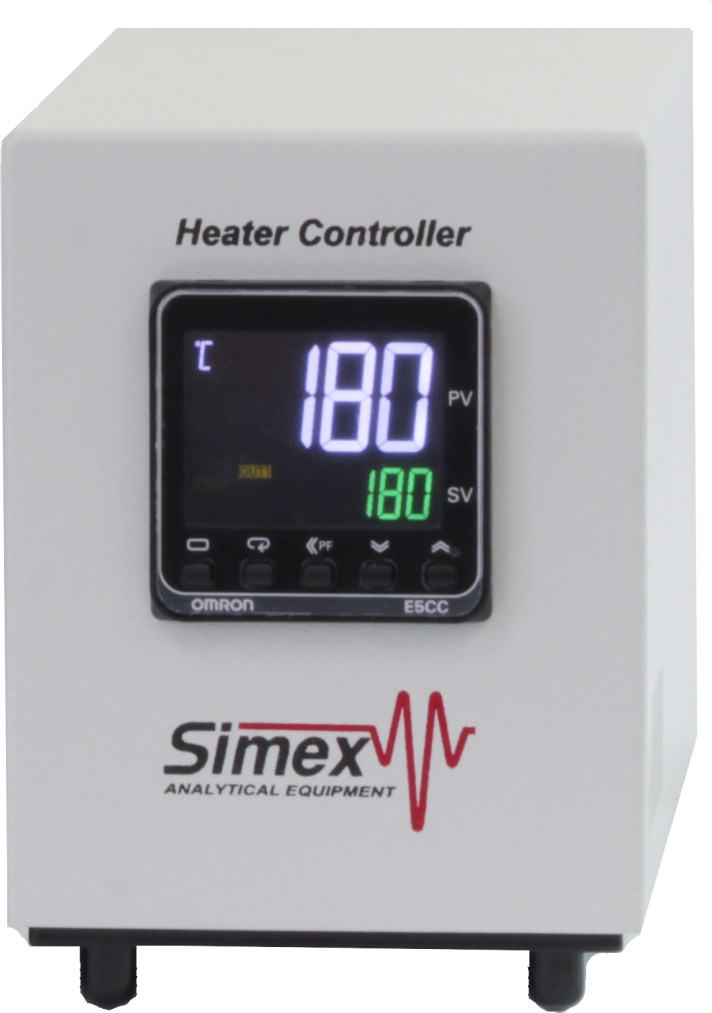
Diamond thermal cell NPVO with temperature controller
The sample heating system is designed to expand the capabilities of standard set-top boxes NPVO-ZDO and NPVO-A. It consists of a heated replaceable frame with a diamond prism and a temperature controller unit.
For most solid samples in the heated state, it is possible to obtain a much more pronounced NPV spectrum than in the cold state. This makes it possible to increase the sensitivity of the method several times.
The properties of some substances and compounds change dramatically with an increase in temperature, chemical interaction processes between components, their decomposition, oxidation in air, etc. may occur. If changes in the chemical composition of a substance occur during heating, a set of spectra corresponding to the kinetics of the process can be obtained with the help of an NPVO prefix with a diamond thermocell and a temperature controller, which is essential expands the possibilities of the method in research.
Technical characteristics of the NPVO set-top box with a thermocell and a controller
Transmission in the operating range of the spectrum, % of the input signal at least 10
The recommended number of scans when registering spectra is 25
Spectrum registration time at 25 scans (resolution 4 cm-1), sec 30
The depth of penetration of radiation into the sample, microns 5 – 15
Minimum dimensions of the solid sample, mm 0.5 × 0.5
Minimum volume of the liquid under study, ml 1
Minimum dimensions of the fiber sample: cross-section diameter/length, mm 0.3/1
The material of the crystal substrate is DIAMOND
The diameter of the free zone of the crystal, mm not less than 2 x 3
The diameter of the focus spot, mm 1.5
Maximum temperature With 220o
Adjustment accuracy, With 1o
Time to reach the maximum temperature, min 10
Overall dimensions, mm 130×200×90
Weight, kg 1,2
SIMEKS
Novosibirsk
Produced in: Novosibirsk
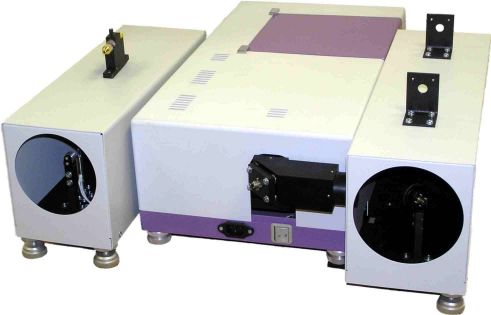
System for remote monitoring of the atmosphere
• Consists of a mirror telescope coupled with a Fourier spectrometer and a searchlight with an IR emitter
• Used to register the spectra of gas and aerosol-gas mixtures on routes up to 100 meters long
• The diameter of the main mirror of the telescope is 170 mm
• Angular field of view +/- 3 degrees.
• An additional reflector can be included in the kit
SIMEKS
Novosibirsk
Produced in: Novosibirsk
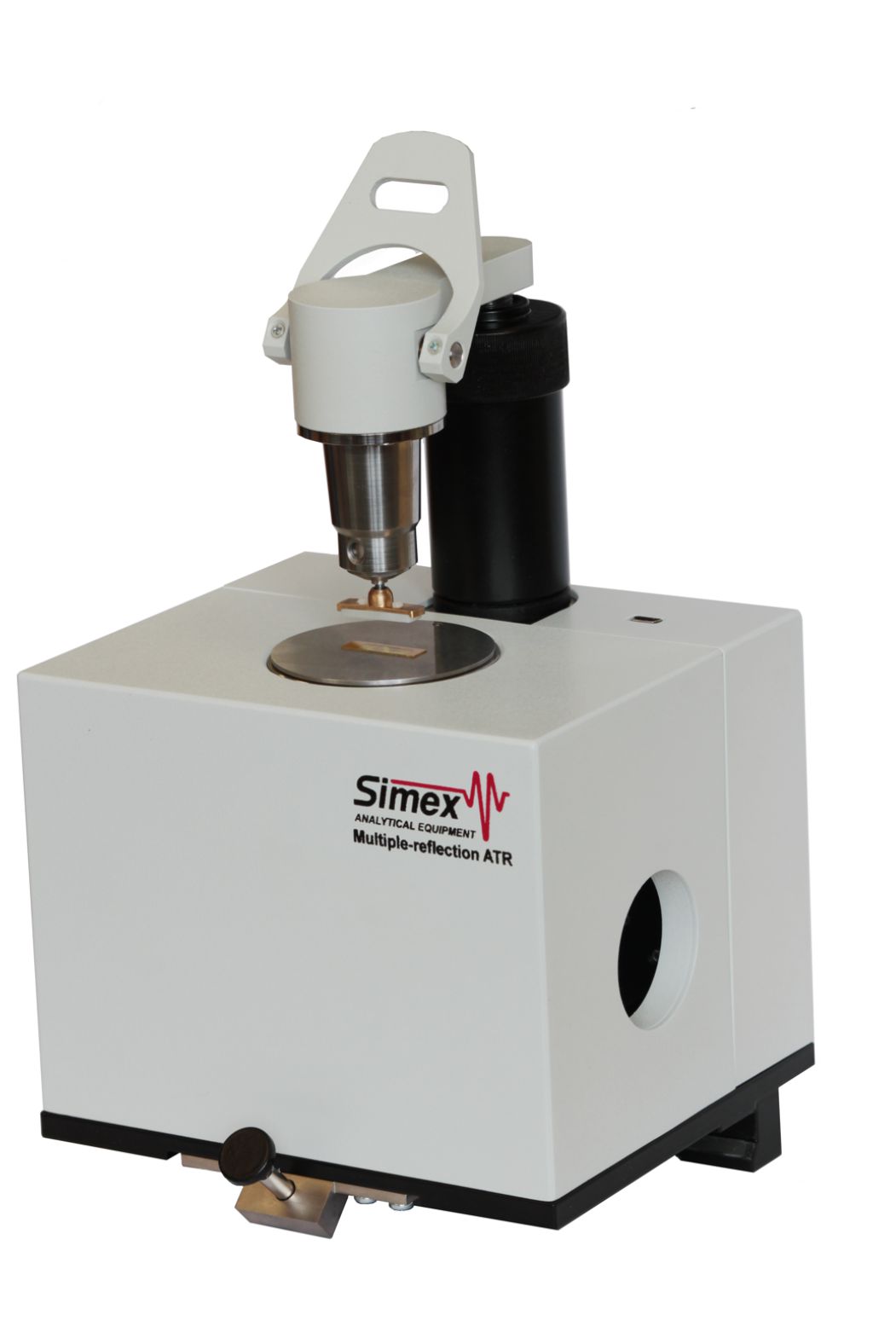
MNPVO prefix with a zinc selenide element and an integrated visualization system on an external monitor
The main difference between this set-top box and the universal set-top box of the NPVO and ZDO is that a prism is used as a working element of the MNPVO, which allows to obtain several reflections from the area of contact with the sample under study, which leads to an improvement in the quality of the spectrum and an increase in the sensitivity of the method (absorption bands become more pronounced). The registration of specular and diffuse reflection spectra (ZDO) is not provided on this set-top box.
The MNPVO prefix is effective in registering the absorption spectra of samples whose dimensions (number) are sufficient to ensure contact with the entire area of the working face of the prism:
* liquids of any degree of viscosity (solutions, suspensions, oils, etc.);
* solid elastic samples (polymer fragments of sufficiently large size, rubbers, plastics, etc.);
* powdered samples in quantities sufficient to be applied to the entire surface and samples in the form of thin tapes;
The universal clamp is equipped with a precision lever mechanism for quickly lowering the tip and a micrometer screw that allows you to pre–set the optimal degree of pressure - this ensures quick sample change and repeatability of the results during measurements. For convenience when working with liquid and paste-like samples, it is possible to rotate the clamping console by 180o.
Note: the MNPVO prefix does not exclude the possibility of registering the spectra of samples whose dimensions are smaller than the area of the working face of the prism (the presence of a visual inspection system of the surface under study increases convenience when working with small-sized objects), but the overall effectiveness of the method is significantly lower than when using the universal NPVO and ZDO prefix.
Transmission in the operating range of the spectrum, % of the input signal of at least 25
· The recommended number of scans when registering spectra is 25
· Spectrum registration time at 25 scans (resolution 4 cm-1), 30 seconds
· The depth of penetration of radiation into the sample, microns 5 – 15
· Minimum area of a solid sample, mm2 1
· Minimum volume of the test liquid, ml 0.3
· The permissible pH range of the analyzed objects is from 5 to 9
· Crystal substrate material ZnSe CVD, Ge
· Diameter of the focus spot, mm 3
· Number of reflections 3
· The size of the working face of the prism, mm 21 X 6
· Magnification of the 4X micro lens
· Total magnification of the visual channel 75X
· Field of view of the optical system, mm 2 X 2.5
· Digital video camera resolution 640 X 480
· Overall dimensions, mm 145×125×240
· Weight, kg 2
SIMEKS
Novosibirsk
Produced in: Novosibirsk

PRIZ - a reflection prefix with the lower position of the sample and visualization of the object under study on the monitor
The main advantage of the PRIZ prefix is the possibility of obtaining well–defined spectra of micro-objects after giving them the shape of a thin layer on mirror-polished metal plates (in the mode of the so-called double passage, when radiation twice penetrates through the layer of matter, reflecting from the mirror-substrate). The presence of a visual control system with a built-in video camera significantly increases the information content when setting up and the reliability of the results obtained. With the help of the prefix, it is also possible to register the reflection spectra of bulk samples and solid objects of arbitrary geometry in native form, including pharmaceuticals in the form of tablets, powders and granules, polymer fragments, LCP, films deposited on the surface.
Technical specifications
Transmission in the operating range of the spectrum, % of the input signal at least 40
The recommended number of scans when registering spectra is 25
Spectrum registration time at 25 scans (resolution 4 cm-1), sec 30
Minimum initial dimensions of a solid sample, mm 0.2 × 0.2
The maximum area of the solid sample, mm 20X20X10
Variable focus range, mm 10
The diameter of the focus spot, mm 3
The angle of incidence of radiation (central beam) on the sample in the ZDO 45o mode
Micro lens magnification / total magnification of the 4X visual channel
Field of view of the optical system, mm 2 X 2.5
The resolution of the digital video camera is 640x480
Overall dimensions, mm 140×105×160
Weight, kg 1.16
SIMEKS
Novosibirsk
Produced in: Novosibirsk
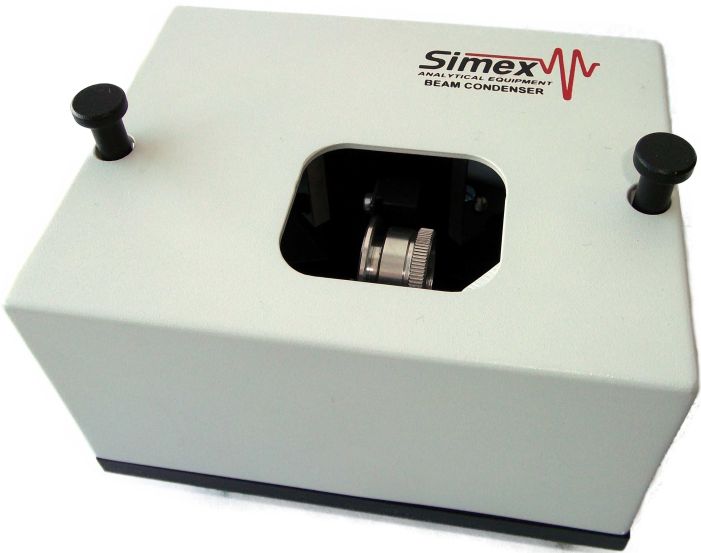
Focusing prefix MKF
It is used in the study of samples compressed into small-diameter tablets with KBr (the method is convenient for spectral analysis of powdery substances - the prefix allows you to work with small amounts of the sample using a manual press for the manufacture of tablets).
• The diameter of the focus spot is less than 3 mm
• Parabolic mirror optics are used in the design
• Windows-substrates can be placed in the prefix after pasty, liquid substances or extracts are applied to them, followed by drying of the layers
• Limited use – in the study of whole samples with dimensions less than 5 mm (preferably using a vertical-type microfocusing attachment)
SIMEKS
Novosibirsk
Produced in: Novosibirsk
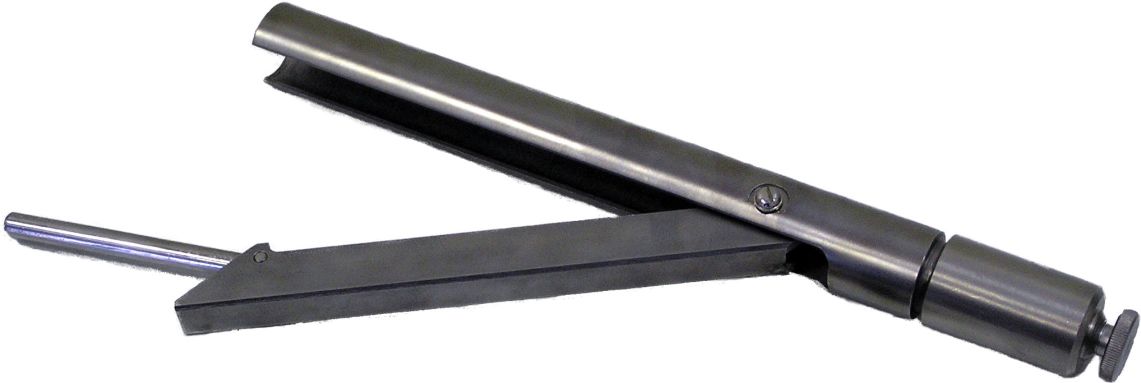
Manual mechanical press
Designed for the preparation of samples in the form of compressed tablets with a diameter of 3.5 mm, consisting of the test substance in a mixture with microcrystalline potassium bromide (KBr).
- the principle of operation of the device is based on creating the pressure necessary for pressing due to a mechanical lever system
- the press is made of high-quality alloy hardened steel
- for the manufacture of a tablet with a diameter of 3.5 mm, a minimum amount of the test substance and KBr is required
- for the study of finished samples on a Fourier spectrometer, a vertical or horizontal microfocusing prefix is used
SIMEKS
Novosibirsk
Produced in: Novosibirsk
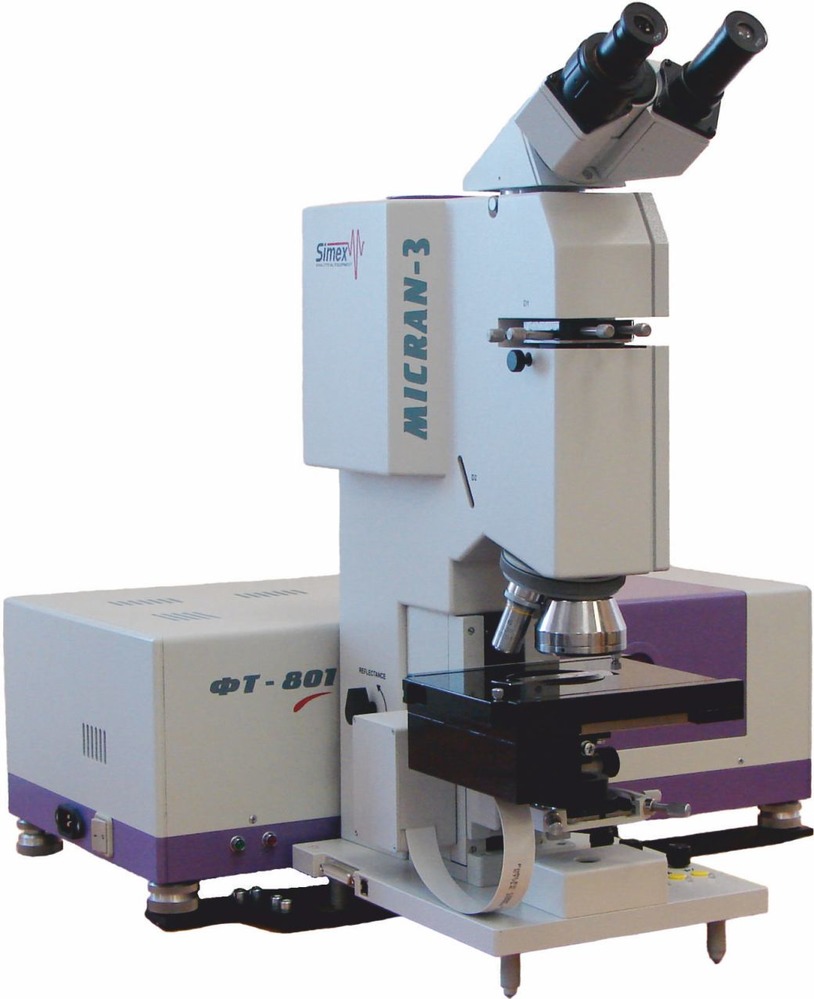
IR microscope "MIKRAN-3"
A higher–level device with extreme sensitivity and an additional set of functions that allow you to expand the possibilities for conducting spectral studies:
· revolver mechanism with 4 interchangeable lenses - mirror IR 15X, NPVO, lens 4X, lens 10X;
· registration of spectra in the modes of specular and diffuse reflection, transmission and NIP;
· increased sensitivity, which allows recording the spectra of micro-objects with sizes from 5 microns;
· built-in control panel with advanced functions;
· automated mapping system;
· the rectangular slit diaphragm is made of special glass – after the fragment is selected, the rest of the field of view is also available to the user, which greatly simplifies photometry of extended surfaces with local inhomogeneities;
· specialized software for controlling the microscope and processing the results.
Liquid nitrogen is required to work with an IR microscope.
SIMEKS
Novosibirsk
Produced in: Novosibirsk
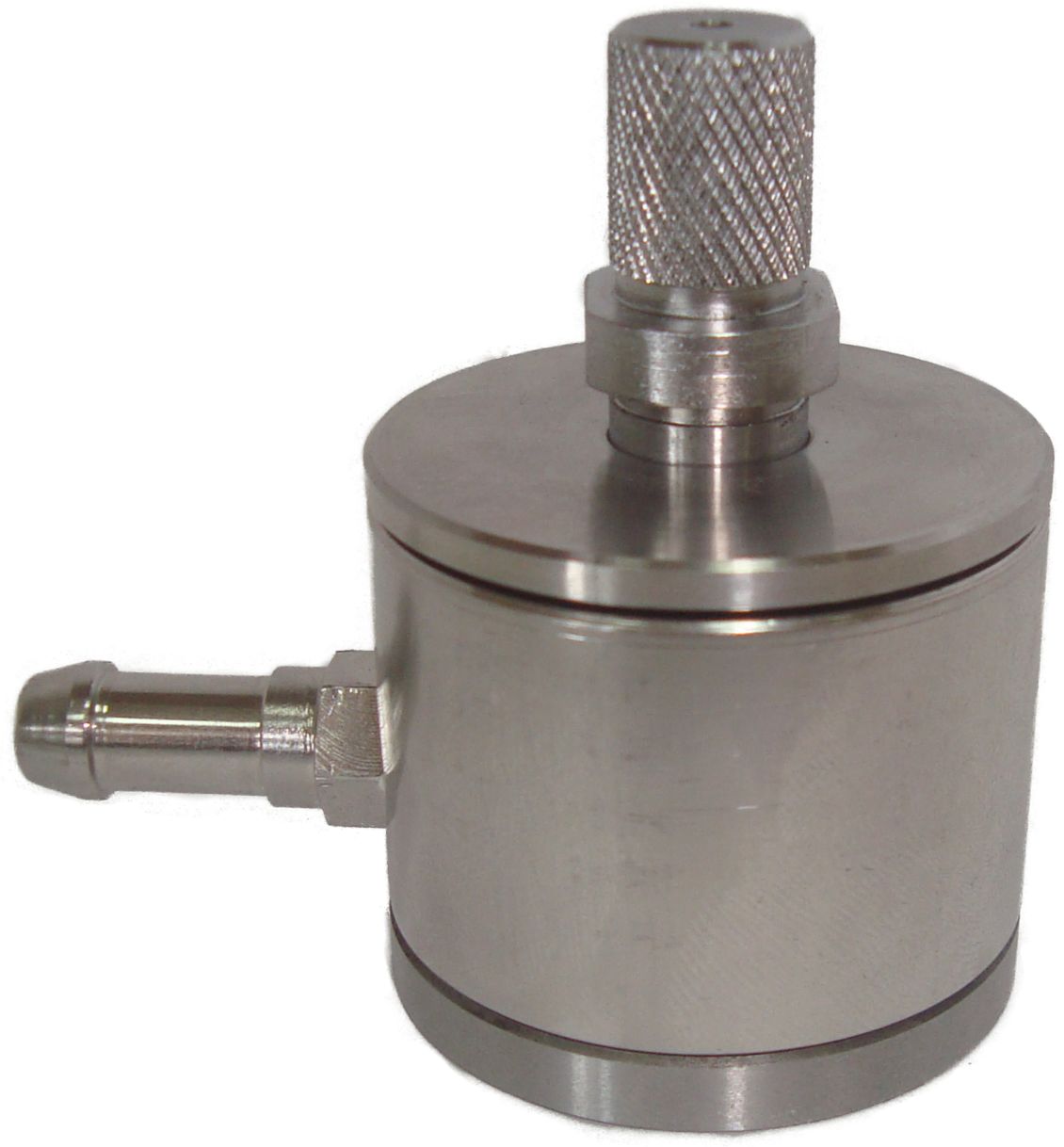
Mold for the manufacture of tablets with KBr diameter of 13 mm
It is intended for the preparation of samples in the form of compressed tablets consisting of the test substance in a mixture with microcrystalline potassium bromide (KBr). The mold is used in combination with the hydraulic press GP 200-13.
- the mold is made of high-quality alloy hardened steel
- to obtain better compressed tablets with KBr, the mold can be pumped out using a pre-vacuum pump. The customer can purchase the pump independently, or order it from the NPF “SIMEX”. Pumping out the mold is not necessary for most studies.
- the kit includes a special dispenser for placing the optimal amount of the pressed mixture in the mold
- to install the finished samples in the spectrometer, a holder of KBr tablets and D13mm substrate windows is used
SIMEKS
Novosibirsk
Produced in: Novosibirsk
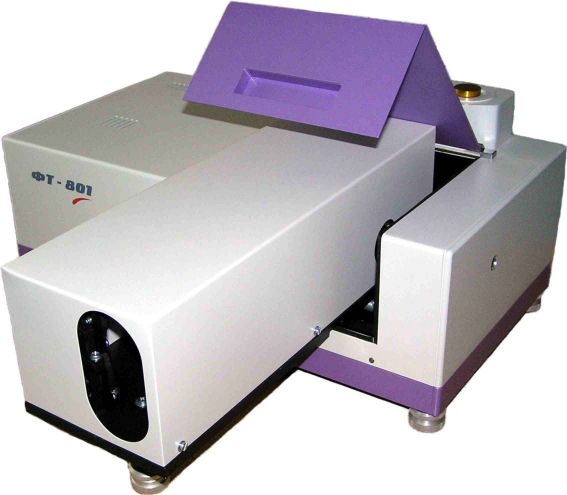
Optical system for recording spectra of substances located in remote closed volumes
Designed for monitoring processes in reactors, vacuum chambers, gas pipelines, etc.
SIMEKS
Novosibirsk
Produced in: Novosibirsk

Reflection prefix PO-45 V
It is intended for express analysis of various types of solid opaque samples, including polymer films and fragments, paint coatings, finished dosage forms in the form of tablets, optical parts and semiconductor materials.
• The sample is located on the subject plane of the investigated surface downwards, the angle of incidence of the central beam on the sample is 45 °
• The diameter of the focus spot is 3 mm
• Allows you to explore objects of any shape and size
• When using a mini-press, it allows you to examine samples in the form of a thin layer rolled out on a mirror plate made of alloy steel (radiation passes through the substance layer twice, reflecting from the mirror surface)
• Not used: for the study of bulk and liquid substances
SIMEKS
Novosibirsk
Produced in: Novosibirsk
